
If 10 students registered for a race but nine of them did not have access to sufficient training to run the distance within qualifying time, we would not be surprised if only one runner actually qualified. Those in higher education circles who report college completion rates don't seem to recognize this dynamic.
With 44 percent of community college freshmen needing to complete remedial courses, it is clear that hundreds of thousands of students are showing up for races they can not complete in qualifying time, according to a study titled "New Evidence on College Remediation."
Because the fastest growing jobs now require some form of postsecondary education, there is a clarion call for those in the workforce to enhance their skills and those out of the workforce to return to school. So, guess what? More and more runners will be showing up for races for which they have not been training.
In some Historically Black Colleges and Universities (HBCUs) and community colleges, the overwhelming majority of college students show up for a race where there is nothing wrong with the racecourse, the weather is good, and the organizers are fair. The problem is that the runners either have not trained intensely enough or simply have not had access to the same training. But they just might finish.
According to the Journal of Blacks in Higher Education article titled, "Black student college graduation rates inch higher but a large racial gap persists," the nationwide college graduation rate for black students stands at an "appalling low" 43 percent. Thus, institutions with even lower graduation rates are often perceived as lacking in academic quality. While conducting research, one author interviewed a university president about the issue. He suggested that his college's reported graduation rate of 9 percent did not imply that there was a quality problem. He said, "If I had an academic quality problem, my graduation rate would be 90 percent," meaning he would allow unqualified students to receive degrees.
Generally speaking, colleges communicate a message to admitted students that says, "You can be successful here." As the traditional college student profile moves further and further away from the 17-year-old high school graduate and closer and closer to the profile of a 27-year-old returning to improve workforce readiness, higher education must also make adjustments. A significant number of students, such as remedial students, adults, first-generation college-goers, and the under-resourced are all showing up for college "races" in droves. And it is widely recognized that these groups tend to take more time to complete their college degrees. Researchers -- Mikyong Minsun Kim, associate professor of higher education at the George Washington University and director of the Virginia campus, and Clifton Conrad, Vilas Distinguished Achievement Professor and professor of higher education, at the University of Wisconsin-Madison -- note that when it comes to measuring graduation rates, persons must take into account students' socioeconomic status and academic preparation.
If we don't re-frame the discussion soon, there will be thousands of people who will complete the race but find very few outside of their family to celebrate their accomplishments. College and university administrators must work together to figure out how to measure success with respect to the changing demographics in college-going trends, instead of just by graduation rates. The major problem with the graduation rate as a measure of success is that it is usually a misleading indicator of an institution's capacity to retain its students. For example, if college A's graduate rate is 70 percent and college B's rate is only 40 percent, that does not mean that college A is better or more effective at retaining students. In fact, college A might actually be even less effective than college B at keeping students in college. It suggests that the two colleges must reevaluate the types of students they admit, according to Alexander Astin. But if that is the case, it could spell disaster for the very students who have historically depended on HBCUs to provide their ticket to the middle class.